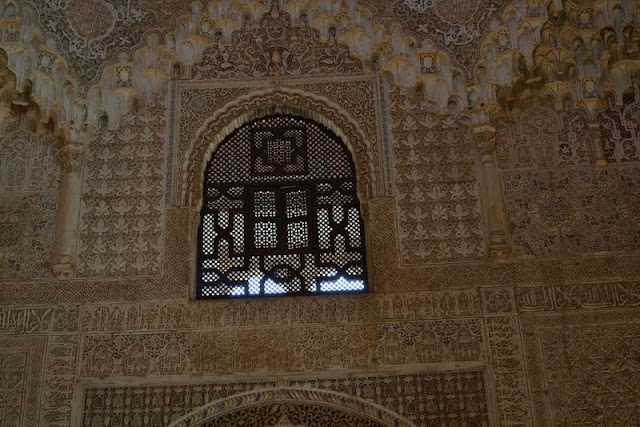Alhambra
The Alhambra
is a palace and fortress complex located in Granada. It was originally
constructed as a fortress in 889 and later converted into a royal palace in
1333 by Yusuf I, sultan of Granada. The Alhambra is a UNESCO World Heritage Site, and
the inspiration for many songs and stories.Moorish poets described it as "a pearl set in emeralds," in allusion
to the colour of its buildings and the woods around them. The decorations
within the palaces typified the remains of Moorish dominion within Spain.
Alhambra
means “The Red” in Arabic , and its complete name was "al Qal'at
al-hamra" (Red fort). The origins of its name are unknown. Some Historians
say it was named that because of the colour of the stones, others say the name
is due to the fact that it was built at night, and the red colour gave it the
appearance of fire emanating from torches. It could also be due to the person
who ordered its construction, the founder of the Nasrid dynasty, Mohammed ben
Nasar, named Al-Hamar el rojo - because he had a red beard.
Nasar built
a super exclusive complex to contain a palace inside a fortress with walls to
resemble paradise .The palace has a number of gardens, trees and fountains – a
right place for kings and queens.
The palace
has fascinating carvings, beautiful tile work, and plaster in lays etc. The
stucco is made up of marble powder and plaster of Paris and white of eggs. The
ceiling is either stucco or wood. Blue is used to represent the sky, green for
trees, yellow the sun and red for the king. The only place where white is used
is in the center of the dome to signify Allah as the white light. It represents
the peak of Islamic art in Spain and one of the most symbolic monuments of this
type of art in the whole world
It is
reported that, once the king saw the queen speaking to a male member of the
royal household. Out of jealousy and unable to recognize who it was, he ordered
the beheading of 12 males of the family. Story goes to say that the blood
stains are still visible in the king’s chambers.
The gardens
have been maintained for 600 years. The fountains are very pretty and the water
comes from the nearby mountains through an aqua duct.The entire place is cool.
The entire area is known as ‘Generlife’.
Figure 11 – Old Roman period foundation
Figure 16 – Inside of the palace living
quarters – high ceiling and lo9ts of light. The intricate designs, arches and
windows
Figure 22 – A rare photo op
Figure 26 – New addition of a church
Costa Del Sol - Malaga
After a pleasant
drive we reached Costa Del Sol. We checked into a very nice hotel overlooking a
Mediterranean beach ‘Tryp Guadalmar’. The Costa del Sol "Sunny Coast"
or more literally, "Coast of the Sun" is a region in the south of
Spain, in the autonomous community of Andalusia,
comprising the coastal towns and communities along the coastline of the Province of malaga. The most important business sector
in Málaga is tourism – exceptionally beautiful town.
Figure 31 – A hilly town with winding
roads
Mijas
Later on in
the evening we drove down to Mijas. Nestled in the luscious Costa del Sol, Mijas
Pueblo is one of the most famous traditional white-washed villages in Spain.
Sometimes called ‘The White City’, Mijas is one of the jewels of the south
coast, renowned for its boisterous festivals, Easter processions and donkey
taxis. The ‘Jet Set’ of Spain have exclusive villas in this place – ‘Marabella’.
They are rumored to take flights from here to attend parties in Monaco, Tangiers
etc. Sean Connery, Roger Moore, Sophia Loren, Alphonso Maximillian are some of
the stars who visit this place often. It was once a very quiet fishing village.Ricardo
Soliano bought lot of real estate and built houses in Marbella for the super
rich.
It is compulsory
to whitewash the hoses and have red tiled roofs. The total picture is very captivating.
Normally the houses have black metallic fences.
It is
common to rent villas to spend your vacation instead of staying in hotels.David
told us that one can rent a two bed room villa for 3000 Euros for a month. Very
attractive indeed.
Figure 42 – It cannot get any better
Figure 43 – White and brown all around












































No comments:
Post a Comment